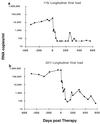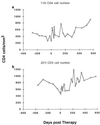Levels of human immunodeficiency virus type 1-specific cytotoxic T-lymphocyte effector and memory responses decline after suppression of viremia with highly active antiretroviral therapy
- PMID: 10400770
- PMCID: PMC112757
- DOI: 10.1128/JVI.73.8.6721-6728.1999
Levels of human immunodeficiency virus type 1-specific cytotoxic T-lymphocyte effector and memory responses decline after suppression of viremia with highly active antiretroviral therapy
Abstract
Therapeutic suppression of human immunodeficiency virus type 1 (HIV-1) replication may help elucidate interactions between the host cellular immune responses and HIV-1 infection. We performed a detailed longitudinal evaluation of two subjects before and after the start of highly active antiretroviral therapy (HAART). Both subjects had evidence of in vivo-activated and memory cytotoxic T-lymphocyte precursor (CTLp) activity against multiple HIV-1 gene products. After the start of therapy, both subjects had declines in the levels of in vivo-activated HIV-1-specific CTLs and had immediate increases in circulating HIV-1-specific CTL memory cells. With continued therapy, and continued suppression of viral load, levels of memory CTLps declined. HLA A*0201 peptide tetramer staining demonstrated that declining levels of in vivo-activated CTL activity were associated with a decrease in the expression of the CD38(+) activation marker. Transient increases in viral load during continued therapy were associated with increases in the levels of virus-specific CTLps in both individuals. The results were confirmed by measuring CTL responses to discrete optimal epitopes. These studies illustrate the dynamic equilibrium between the host immune response and levels of viral antigen burden and suggest that efforts to augment HIV-1-specific immune responses in subjects on HAART may decrease the incidence of virologic relapse.
Figures







Similar articles
-
Anti-human immunodeficiency virus type 1 (HIV-1) CD8(+) T-lymphocyte reactivity during combination antiretroviral therapy in HIV-1-infected patients with advanced immunodeficiency.J Virol. 2000 May;74(9):4127-38. doi: 10.1128/jvi.74.9.4127-4138.2000. J Virol. 2000. PMID: 10756025 Free PMC article.
-
Alterations in T cell phenotype and human immunodeficiency virus type 1-specific cytotoxicity after potent antiretroviral therapy.J Infect Dis. 2001 Mar 1;183(5):722-9. doi: 10.1086/318816. Epub 2001 Feb 1. J Infect Dis. 2001. PMID: 11181148 Clinical Trial.
-
Evidence of immune reconstitution in antiretroviral drug-experienced patients with advanced HIV disease.AIDS Res Hum Retroviruses. 2002 Jan 20;18(2):95-102. doi: 10.1089/08892220252779638. AIDS Res Hum Retroviruses. 2002. PMID: 11839142 Clinical Trial.
-
Reduction in CD8+ cell noncytotoxic anti-HIV activity in individuals receiving highly active antiretroviral therapy during primary infection.Proc Natl Acad Sci U S A. 2001 Jan 16;98(2):597-602. doi: 10.1073/pnas.98.2.597. Epub 2001 Jan 2. Proc Natl Acad Sci U S A. 2001. PMID: 11136234 Free PMC article.
-
Parallel decline of CD8+/CD38++ T cells and viraemia in response to quadruple highly active antiretroviral therapy in primary HIV infection.AIDS. 2002 Mar 8;16(4):589-96. doi: 10.1097/00002030-200203080-00010. AIDS. 2002. PMID: 11873002
Cited by
-
Antiretroviral therapy reduces the magnitude and T cell receptor repertoire diversity of HIV-specific T cell responses without changing T cell clonotype dominance.J Virol. 2012 Apr;86(8):4213-21. doi: 10.1128/JVI.06000-11. Epub 2012 Jan 18. J Virol. 2012. PMID: 22258246 Free PMC article.
-
Heterogeneity in chronic myeloid leukaemia dynamics during imatinib treatment: role of immune responses.Proc Biol Sci. 2010 Jun 22;277(1689):1875-80. doi: 10.1098/rspb.2009.2179. Epub 2010 Feb 10. Proc Biol Sci. 2010. PMID: 20147328 Free PMC article.
-
Fluctuations of functionally distinct CD8+ T-cell clonotypes demonstrate flexibility of the HIV-specific TCR repertoire.Blood. 2006 Mar 15;107(6):2373-83. doi: 10.1182/blood-2005-04-1636. Epub 2005 Dec 1. Blood. 2006. PMID: 16322475 Free PMC article.
-
Early initiation of antiretroviral treatment postSIV infection does not resolve lymphoid tissue activation.AIDS. 2017 Aug 24;31(13):1819-1824. doi: 10.1097/QAD.0000000000001576. AIDS. 2017. PMID: 28692537 Free PMC article.
-
Modeling dynamics of acute HIV infection incorporating density-dependent cell death and multiplicity of infection.PLoS Comput Biol. 2024 Jun 7;20(6):e1012129. doi: 10.1371/journal.pcbi.1012129. eCollection 2024 Jun. PLoS Comput Biol. 2024. PMID: 38848426 Free PMC article.
References
-
- Altman J D, Moss P A H, Goulder P J R, Barouch D H, McHeyzer-Williams M G, Bell J I, McMichael A J, Davis M M. Phenotypic analysis of antigen-specific T lymphocytes. Science. 1996;274:94–96. - PubMed
-
- Brander C, Hartman K E, Trocha A K, Jones N G, Johnson R P, Korber B, Wentworth P, Buchbinder S P, Wolinsky S, Walker B D, Kalams S A. Lack of strong immune selection pressure by the immunodominant, HLA-A*0201-restricted cytotoxic T lymphocyte response in chronic human immunodeficiency virus-1 infection. J Clin Investig. 1998;101:2559–2566. - PMC - PubMed
-
- Carmichael A, Jin X, Sissons P, Borysiewicz L. Quantitative analysis of the human immunodeficiency virus type 1 (HIV-1)-specific cytotoxic T lymphocyte (CTL) response at different stages of HIV-1 infection: differential CTL responses to HIV-1 and Epstein-Barr virus in late disease. J Exp Med. 1993;177:249–256. - PMC - PubMed
-
- Dalod M, Harzic M, Pellegrin I, Dumon B, Hoen B, Sereni D, Deschemin J C, Levy J P, Venet A, Gomard E. Evolution of cytotoxic T lymphocyte responses to human immunodeficiency virus type 1 in patients with symptomatic primary infection receiving antiretroviral triple therapy. J Infect Dis. 1998;178:61–69. - PubMed
Publication types
MeSH terms
Substances
Grants and funding
LinkOut - more resources
Full Text Sources
Other Literature Sources
Medical
Research Materials

